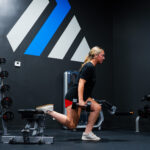Sports Specific Training for Youth Athletes
As youth sports become more competitive, the demand for focused, effective training continues to grow. But for young athletes, the right approach is essential. Sports specific training provides a safe and smart way to help kids develop the skills, movement patterns, and confidence needed for success in their chosen sport.
Unlike general workouts, this training method builds abilities that translate directly to game performance—without putting growing bodies at risk.
Why Youth Athletes Need a Different Approach
Youth athletes aren’t just “small adults.” Their bodies are still developing, which means training must be:
-
Age-appropriate
-
Skill-focused, not load-focused
-
Centered on fun and safety
-
Designed to develop coordination and motor skills
Overtraining or pushing heavy strength work too early can lead to injuries and burnout. A structured sports specific training plan keeps development safe, gradual, and effective.
Benefits of Sports Specific Training for Youth
1. Builds Sport-Relevant Skills
Young athletes gain agility, balance, coordination, and timing that transfers directly to the field or court.
2. Encourages Long-Term Development
It supports proper movement patterns now to avoid injury and poor habits later.
3. Boosts Confidence
Kids gain confidence by learning the specific skills they need for their sport.
4. Reduces Risk of Overuse Injuries
Balanced training ensures muscles and joints develop together, not unevenly.
5. Keeps Training Fun
Training tailored to the sport feels like play, keeping kids engaged and motivated.
What Should Youth Sports Specific Training Include?
Effective training for youth athletes focuses on five key areas:
1. Motor Skill Development
Before building muscle, kids need to master movement. Drills that emphasize running, skipping, hopping, and jumping are foundational.
2. Balance and Coordination
Use balance pads, reaction drills, and single-leg exercises to challenge coordination in motion.
3. Sport-Specific Movement
Teach young athletes how to move like their sport demands—cutting for soccer, pivoting for basketball, or swinging for tennis.
4. Light Resistance and Bodyweight Strength
Strength should come through bodyweight training and resistance bands—not heavy weights.
5. Injury Prevention
Include exercises that build strong ankles, hips, and core for better joint control and fewer injuries.
Weekly Youth Training Plan Example
| Day | Focus |
|---|---|
| Monday | Full-body movement + agility |
| Tuesday | Light strength + coordination drills |
| Wednesday | Recovery play + mobility |
| Thursday | Sport-specific drills + reaction time |
| Friday | Core + balance + movement games |
| Saturday | Game or scrimmage simulation |
| Sunday | Rest |
Training should be short (30–45 minutes) and varied to hold attention.
Sample Drills for Young Athletes
Cone Relay Races
Purpose: Improve agility and directional speed
How to do it: Set up cones in a zigzag. Kids run, shuffle, and sprint through them in teams.
Balance Pad Toss
Purpose: Train balance and hand-eye coordination
How to do it: Stand on one foot on a foam pad while tossing and catching a ball.
Skater Jumps
Purpose: Build lateral speed and coordination
How to do it: Hop side to side on one foot like a speed skater, landing softly.
Partner Mirror Drill
Purpose: Boost reaction and agility
How to do it: One partner moves laterally while the other mirrors them as quickly as possible.
Light Band Kicks
Purpose: Strengthen hip flexors and glutes
How to do it: Loop a resistance band around both legs. Kick forward, side, and back with control.
These exercises build fundamentals without stressing the joints or overloading growing muscles.
What to Avoid in Youth Sports Training
While training is essential, some approaches can harm rather than help. Here’s what to avoid:
-
Heavy lifting too early: Focus on movement quality before adding weight.
-
Overtraining: More isn’t always better—young bodies need rest.
-
Specializing too early: Playing multiple sports prevents overuse injuries and builds all-around athleticism.
-
Skipping warm-ups and cool-downs: Mobility and proper prep are key for injury prevention.
Safety Guidelines for Parents and Coaches
To keep sports specific training effective and safe:
-
Use soft surfaces like turf or grass
-
Keep sessions short and engaging
-
Incorporate fun games and challenges
-
Emphasize technique, not intensity
-
Listen for signs of fatigue or pain
Always remember—kids should enjoy the process. When it’s fun, progress follows.
Where to Train
Want expert help developing your youth athlete’s skills? Next Level Athletics offers tailored youth sports specific training programs that focus on movement, safety, and sport skill development.
Need more guidance on youth fitness? Healthline has a helpful overview of activity benefits for kids.
Conclusion: Build the Foundation for Lifelong Success
Training young athletes is about laying the groundwork—not rushing results. With safe, effective sports specific training, youth athletes build the physical tools, mental confidence, and love for movement that will support them for years to come.
Keep it fun, keep it focused, and always train with the long game in mind.


Recent Comments